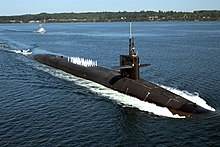Second strike
A second strike is the reaction to a first strike . Since the Cold War , this term from nuclear strategy has stood for the “ retaliatory strike ” carried out as a direct military reaction to an attack with nuclear weapons .
Second strike ability
In order to be able to carry out a second strike even after a massive first strike, the nuclear powers developed the following concepts:
- Particularly well-protected, hidden and / or mobile ICBMs , which even after a nuclear attack that would have destroyed large stretches of land and the infrastructure , offer the possibility of a devastating counterstrike;
- strategic submarines equipped with sea-based ICBMs operate “deterrent patrols”;
- Long-range bombers with nuclear - armed cruise missiles or atomic bombs .
This three-way division, the so-called “nuclear triad”, is intended to guarantee the ability to strike a second strike , since it is unlikely that all nuclear weapons can be destroyed in a first strike.
impact
The awareness that, despite having carried out a nuclear first strike, one would still suffer intolerable losses as a result of the opponent's nuclear counter-attack, is seen as an important factor that prevented a nuclear attack and thus secured peace through deterrence ( mutual assured destruction ). From this arose the doctrine of renouncing the first use of nuclear weapons.
Second strike capacities
The most important devices and weapon systems for the second strike are:
- ICBMs such as the Soviet SS-18 or the US Peacekeeper (until 2005)
- Nuclear submarines
- Missile silos
- mobile launching ramps (Soviet Union / Russia) on road and rail
- nuclear-armed cruise missiles
- The automatic command center Dead Hand of the Soviet Union, which should initiate a second strike even if the political leadership is eliminated by releasing the weapons. The Americans had a similar system with Looking Glass .
literature
- Enrico Fels: Will the Eagle strangle the Dragon? An Assessment of the US Challenges towards China's Nuclear Deterrence. ( Memento of March 4, 2009 in the Internet Archive ) (PDF; 128 kB) Trends East Asia Study No. 20 (February 2008).
